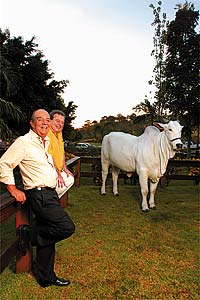|
|
All want the Green Ox
01/02/2005

Cattle created at the pasture: low cost and synonym of safety alimentary
Following the trail of the agriculture, the Brazilian livestock gave a great quality jump in the last decade and it is conquering markets more and more. It is from Brazilian pastures that leaves good part of the bovine meat consumed at several countries in Europe, in Middle East, in Africa and in Latin America. Last year, Brazil - that has the largest flock bovine commercial of the world, with almost an ox for habitant - assumed the leadership of the world market of the section, passing ahead of Australia and of the United States. In the last five years, the revenue with external sales of the product almost triplicated. It should arrive at 2,6 billion of Real in 2005.
That result becomes more expressive when it is analyzed that, due to sanitary barriers, the Brazilian meat "in natura" doesn't have access of any of the largest markets in the planet, like Japan, South Korea and the countries of the Nafta (United States, Canada and Mexico). In spite of 80% of the national bovine flock to be concentrated in areas free from the fever aftosa, the American government only authorizes the purchase of industrialized meat (cooked and canned) and, with that, it influences the position of the other countries to follow their commercial guidelines. Recent focuses of the disease, registered in Pará and in Amazon, they helped to call attention for the need of cares in that area, under penalty of that might lost other important markets.

Entrepreneurs Jonas Barcellos and João Carlos Di Gênio, with the Olympic supercown of the Old Forest: 3,2 million of Real
The Brazilian cattle farmers are prejudiced also for the protectionism of the rich countries. Each European cow, for instance, receives from the public safes an average of 3 dollars of subsidies a day. The impediments protectionists and the sanitary barriers, however, they have not been enough to brake the blowout of the Brazilian herd heading for several songs of the planet. One of the explanations is the fact of the national ox-call of "green ox" for being created at the pasture-to have a cost of much smaller production than the one of the confined, whose feeding is just made to the ration base.
The Brazilian meat also turned synonym of safety alimentary after the expansion, in 1999, of the evil of the mad cow, whose cause is attributed to animal proteins contained in the rations used by European farmers. Ever since, the world has an eye on the Brazilian steak. Four years ago, the exportation was restricted the only forty markets. Now, it crosses a hundred. "Of the corral to the ship, going by the freezer, the Brazilian meat is the healthiest and competitive of the world", it guarantees Victor Nehmi, of FNP Consultoria.
The good acting of the livestock is fruit of the domestication of the zebu, the rustic cattle that began to be imported of India by pioneers from Minas Gerais starting from the end of the century XIX. Today, 80% of the national flock have blood of races zebuins, with prominence for the nelore, that is more resistant to adversities of the tropical climate, as diseases and parasites. Great part of the oxen and cows also grew up by genetic improvements, done more intensive form through a technique called industrial crossing. For that method, races zebuins are blended with Europeans, that win weight in less time and they have the softest meat. The competitiveness and the quality of the Brazilian meat are directly linked the that equation, that is only in the world", affirms Marcus Vin
Source: Veja Magazine
|

|